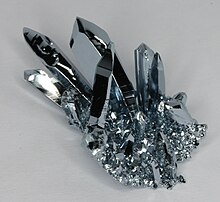Osmium
History:
Osmium is a chemical element with symbol Os and atomic number 76. It is a hard and brittle transition metal in the platinum group. Osmium is the densest naturally occurring element, with a density of 22.59 g/cm3. This metal was first discovered in 1803 by Smithson Tennant and William Hyde Wollaston in London, England. Osmium was discovered along side other metals like platinum and those that are in the platinum group.
Occurrence:
Osmium is the least abundant stable element in Earth's crust with an average mass fraction of 50 parts per trillion in the continental crust. It is found in three main areas on earth. These areas include: igneous deposits (crustal intrusions from below), impact craters, and deposits reworked from one of the former structures. The largest known primary reserves are in the Bushveld igneous complex in South Africa. There are smaller reserves in the United states.
Mining and Production:
Osmium is obtained commercially as a by-product from nickel and copper mining and processing. During electro refining of copper and nickel, metals in the platinum group sink down to the bottom portion of the cell in something called anode mud. From there, osmium is still surrounded by other metals of similar properties. There is a series of different solutions that are used to dissolve osmium away from the other metals and once dissolved, the product is reduced using hydrogen, yielding the metal as a powder or sponge that can be treated using powder metallurgy techniques.
Application:
Because of the extreme toxicity of its oxide, osmium is rarely used in its pure state, and is instead often alloyed with other metals. Uses include: finger printing identification, detecting fatty cells in electron microscopes, osmium coated mirrors were flown in several space missions due to the high UV light reflection.
Price:
Osmium is usually sold as a minimum 99.9% pure powder. It is measured by troy weight and by grams. Its price in 2012 was about $400 per troy ounce (or about $13,000 per kilogram).
Mining and Production:
Osmium is obtained commercially as a by-product from nickel and copper mining and processing. During electro refining of copper and nickel, metals in the platinum group sink down to the bottom portion of the cell in something called anode mud. From there, osmium is still surrounded by other metals of similar properties. There is a series of different solutions that are used to dissolve osmium away from the other metals and once dissolved, the product is reduced using hydrogen, yielding the metal as a powder or sponge that can be treated using powder metallurgy techniques.
Application:
Because of the extreme toxicity of its oxide, osmium is rarely used in its pure state, and is instead often alloyed with other metals. Uses include: finger printing identification, detecting fatty cells in electron microscopes, osmium coated mirrors were flown in several space missions due to the high UV light reflection.
Price:
Osmium is usually sold as a minimum 99.9% pure powder. It is measured by troy weight and by grams. Its price in 2012 was about $400 per troy ounce (or about $13,000 per kilogram).

No comments:
Post a Comment